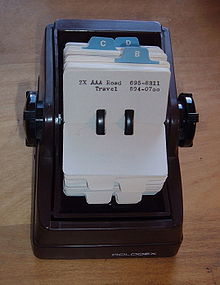 One of my pet peeves is the use of a Rolodex. In many cases they are not utilized effectively as an important business development tool. And in the modern era, the Rolodex has been reduced to little more than an electronic repository for business cards.
One of my pet peeves is the use of a Rolodex. In many cases they are not utilized effectively as an important business development tool. And in the modern era, the Rolodex has been reduced to little more than an electronic repository for business cards.
Note: For those of you unfamiliar with the term, a Rolodex is a rotating file device used to share business contact information. However, to clarify for this article I consider the Rolodex, business card file and Contacts list interchangeably to mean the same thing.
For years in the corporate world, I listened to executives talk about their “who’s who” list of contacts and the size of their Rolodex, like this somehow made them more important. However, when it came to helping a sales team member with an executive introduction, closing a sale or resolving a customer problem, their Rolodex of business contacts was rarely of any value in helping move things along.
Several years ago, I met with a Director of Business Development candidate who began the interview by telling me that he had a Rolodex of over 2,000 businesses. I said that’s great … now tell me how many of those businesses you could call right now, get an appointment in the next week and close a sale in the next 30 days if you were offered the position?
You get my point. Your Rolodex is of no value unless it helps you grow your business and make money. So, how do you turn your Rolodex into cash? Here are a few things I would recommend for starters.
- Purge your existing Rolodex of all business contacts that are not active. This will help you to narrow your focus and put more emphasis on those current relationships that are vital to your business growth.
- Don’t add new contacts to your Contacts list until you have developed a positive business relationship with that person. I would underscore the word positive – no energy vampires allowed!
- Limit your business contacts to 3 or 4 specific areas – i.e. clients, partners, suppliers and “other”. This will help you to prioritize and eliminate the clutter.
- Establish group categories in Outlook, as an example, to make it easier for you to access and retrieve business contact lists by category designation, as needed.
- Retain the remaining business cards you have accumulated for later use – i.e. newsletters, prospect mailings, etc., but keep them separated from your active Rolodex contacts.
Much the same as networking, developing an effective Rolodex or Contacts list you can turn into cash is about building relationships, not stockpiling business cards. Your prospect database, email and vendor lists are more appropriate placeholders for this additional stored information.
Constructing your Rolodex in this manner will help you to put more emphasis on the customer, partner and supplier relationships that are integral to your future success, while turning your Rolodex into cash today.
COPYRIGHT © 2010-11 John Carroll